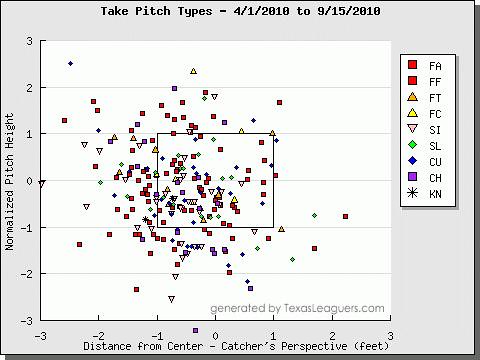I admit it. I have a weakness for patient hitters. I thoroughly enjoy watching a hitter take control of an at-bat and torture a struggling pitcher by refusing to chase anything out of the zone. At times, I even tend to place too great an emphasis on an individual player’s plate discipline, overlooking his hitting ability in the process. Having said that, I think Pedro Alvarez could greatly improve his production by being more aggressive at the plate.
If you have regularly watched Alvarez bat, you probably get a feeling of dread deep in your stomach any time the count gets to two strikes. There is good reason for that. Alvarez only makes contact on 67.9% of his swings, well below the league average of 80.8%. For a point of reference, Mark Reynolds (62.5%), Miguel Olivo (66.0%) and Russell Branyan (67.1%) are the only players with 400+ plate appearances to post lower contact rates in 2010. With that swing-and-miss tendency, Alvarez is in trouble in every at-bat in which the strike total approaches three. As you might expect, his two-strike stats are abysmal.
| AVG | OBP | SLG | K/PA | |
| Pedro Alvarez | .127 | .184 | .259 | 57.0% |
| MLB | .182 | .252 | .278 | 37.9% |
Considering the extent to which Alvarez has struggled with two strikes, it seems logical that he should make every effort to avoid getting to that point. A player with a high contact rate can afford to fall into a two-strike count. Alvarez is not that type of hitter. He needs to maximize the potential of all three available strikes in every single at-bat. I am not sure he is doing that.
O-Swing% - Percentage of pitches a batter swings at outside the strike zone
Z-Swing% - Percentage of pitches a batter swings at inside the strike zone
| O-Swing% | Z-Swing% | |
| Pedro Alvarez | 30.0% | 61.9% |
| MLB | 29.3% | 64.4% |
Alvarez swings at pitches inside the strike zone a bit less often than the average hitter does. There is nothing wrong with that in a vacuum, but the majority of hitters who take a high percentage of strikes have high contact rates. Guys like Brett Gardner and Joe Mauer can afford to patiently wait for their pitch, because they have a low risk for strikeout as they get deep in counts. The more successful low-contact hitters, such as Adam Dunn and Ryan Howard, offer at strikes at an above average rate. Staying away from two-strike counts should be a priority for these types of hitters.
| Z-Swing% | Contact% | |
| Pedro Alvarez | 61.9% | 67.9% |
| Brett Gardner | 44.3% | 90.5% |
| Joe Mauer | 55.8% | 91.0% |
| Adam Dunn | 68.0% | 68.9% |
| Ryan Howard | 68.4% | 68.5% |
Texasleaguers.com gives us the ability to view Alvarez’s pitch locations in each count. Here are the locations of every pitch Alvarez has taken to start an at-bat. As a reminder, these are from the catcher’s point of view.
Compared to your typical hitter, this is not that unusual of a graphic. Alvarez often takes the first pitch, including many within the strike zone, as most hitters do. However, from this data, it appears that he is looking for a pitch on the inner half of the plate early in every at-bat. This gives pitchers the freedom to start him off with a strike on the outer half, causing Alvarez to fall behind in the count immediately. If you look at Alvarez’s charts for 1-0 and 2-0 counts, you will see that they look fairly similar. Pedro has shown that he is perfectly willing to watch that first strike, eliminating a valuable opportunity to put the ball in play.
In Thursday night’s game against the Mets, Alvarez doubled to left-center in his first at-bat. The solidly struck hit came on a fastball on the outer half of the plate, early in the count. As Pedro grows and evolves as a hitter, hopefully we will see that type of swing more often.



